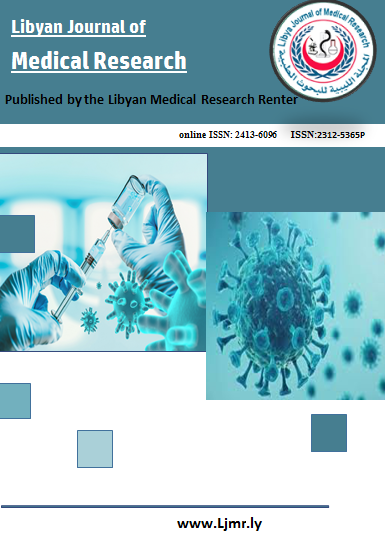Prevalence of Hypoglycemia in Infants of Diabetic Mothers Admitted to the Neonatal Intensive Care Unit at Tobruk Medical Center
DOI:
https://doi.org/10.54361/ljmr.19.1.19Keywords:
Hypoglycemia, Infant, Newborn,, Diabetes Mellitus, HyperinsulinismAbstract
Purpose: Neonatal hypoglycemia is a frequent metabolic complication among infants of diabetic mothers (IDMs), primarily due to maternal hyperglycemia-induced fetal hyperinsulinemia. This study aimed to determine the prevalence of hypoglycemia in IDMs admitted to the Neonatal Intensive Care Unit (NICU) at Tobruk Medical Center (TMC) and identify associated maternal and neonatal factors.
Methods: A retrospective cross-sectional study analyzed 101 IDMs admitted to the NICU between April 2023 and April 2024. Maternal data (diabetes type, glycemic control, obstetric history) and neonatal parameters (hypoglycemia, birth weight, Apgar scores, comorbidities) were extracted from medical records. Hypoglycemia was defined as blood glucose <35 mg/dL within the first 72 hours of life. Statistical analyses included descriptive statistics and independent t-tests, with significance set at p<0.05.
Results: Hypoglycemia occurred in 75.2% of IDMs. The cohort was nearly evenly split between pre-gestational (48.5%) and gestational diabetes (51.5%) mothers. Infants of pre-gestational diabetic mothers had lower mean glucose levels (36.61 mg/dL) compared to those of gestational diabetic mothers (43.67 mg/dL), though not statistically significant (p=0.063). Cesarean deliveries were common (69.3%), with 58.4% of infants being large-for-gestational-age (LGA) and 20.8% experiencing respiratory distress. Intravenous dextrose was required in 52.5% of cases.
Conclusion: Hypoglycemia remains highly prevalent among IDMs, highlighting the critical need for optimal maternal glycemic control during pregnancy and vigilant neonatal glucose monitoring postpartum. The observed glucose differences between diabetes types merit further investigation to guide targeted interventions.
Downloads
References
1. Osenko IR, Kitzmiller JL, Loo SW, Blix P, Rubenstein AH, Gabbay KH. The infant of the diabetic mother: correlation of increased cord C-peptide levels with macrosomia and hypoglycemia. N Engl J Med. 1979 Oct 18;301(16):859-62.
2. Enon RK, Cohen RM, Sperling MA, Cutfield WS, Mimouni F, Khoury JC. Transplacental passage of insulin in pregnant women with insulin-dependent diabetes mellitus. Its role in fetal macrosomia. N Engl J Med. 1990 Aug 2;323(5):309-15.
3. iggins M, McAuliffe F. A review of maternal and fetal growth factors in diabetic pregnancy. Curr Diabetes Rev. 2010 Mar;6(2):116-25.
4. an Haeften TW. Clinical significance of insulin antibodies in insulin-treated diabetic patients. Diabetes Care. 1989 Oct;12(9):641-8.
5. a R, Wang P, Yang Q, Zhu Y, Zhang L, Wang Y, et al. Interpregnancy interval and early infant neurodevelopment: the role of maternal-fetal glucose metabolism. BMC Med. 2024 Jan 2;22(1):2.
6. u X, Chen F. Exogenous insulin antibody syndrome (EIAS): a clinical syndrome associated with insulin antibodies induced by exogenous insulin in diabetic patients. Endocr Connect. 2018 Jan;7(1):R47-R55.
7. ranmer H. Neonatal Hypoglycemia. In: Cameron P, Jelinek G, Kelly AM, Brown AF, Little M, editors. Textbook of Adult Emergency Medicine. 4th ed. Elsevier; 2015. p. 103-5.
8. oss CR. Neonatal Hypocalcemia in the Infant of a Diabetic Mother. Neonatal Netw. 2020 Jul 1;39(4):212-8.
9. inker SC, Gilboa SM, Moore CA, Waller DK, Simeone RM. Specific birth defects in pregnancies of women with diabetes: National Birth Defects Prevention Study, 1997–2011. Am J Obstet Gynecol. 2020 Feb;222(2):176.e1-176.e11.
10. omura Y, Marks DJ, Grossman B, Yoon M, Loudon H, Stone J, et al. Exposure to gestational diabetes mellitus and low socioeconomic status: effects on neurocognitive development and risk of attention-deficit/hyperactivity disorder in offspring. Arch Pediatr Adolesc Med. 2012 Jan;166(4):337-43.
11. izzo TA, Dooley SL, Metzger BE, Cho NH, Ogata ES, Silverman BL. Early malnutrition and child neurobehavioral development: insights from the study of children of diabetic mothers. Child Dev. 1995 Dec;66(6):2125-42.
12. eBoer T, Wewerka S, Bauer PJ, Georgieff MK, Nelson CA. Explicit memory performance in infants of diabetic mothers at 1 year of age. Dev Med Child Neurol. 2005 Aug;47(8):525-31.
13. alkins K, Devaskar SU. Fetal origins of adult disease. Curr Probl Pediatr Adolesc Health Care. 2011 Jul;41(6):158-76.
14. awdon JM, Ward Platt MP, Aynsley-Green A. Patterns of metabolic adaptation for preterm and term infants in the first neonatal week. Arch Dis Child. 1992 Jul;67(7 Spec No):357-65.
15. ornblath M, Ichord R. Hypoglycemia in the neonate. Semin Perinatol. 2000 Feb;24(2):136-49. hese references provide a comprehensive overview of the relationship between maternal diabetes and neonatal hypoglycemia, including studies on metabolic control, insulin antibodies, and neonatal outcomes.
Downloads
Published
Issue
Section
License
Copyright (c) 2025 Amani E Bidalla, Nouri M Mumash, Norha S Mohammed, Albatoul H Ahamad, Ahmed S Mikael (Author)

This work is licensed under a Creative Commons Attribution-NonCommercial-NoDerivatives 4.0 International License.
Open Access Policy
Libyan journal of medical Research (LJMR).is an open journal, therefore there are no fees required for downloading any publication from the journal website by authors, readers, and institution.
The journal applies the license of CC BY (a Creative Commons Attribution 4.0 International license). This license allows authors to keep ownership f the copyright of their papers. But this license permits any user to download , print out, extract, reuse, archive, and distribute the article, so long as appropriate credit is given to the authors and the source of the work.
The license ensures that the article will be available as widely as possible and that the article can be included in any scientific archive.
Editorial Policy
The publication of an article in a peer reviewed journal is an essential model for Libyan journal of medical Research (LJMR). It is necessary to agree upon standards of expected ethical behavior for all parties involved in the act of publishing: the author, the journal editorial, the peer reviewer and the publisher.
Any manuscript or substantial parts of it, submitted to the journal must not be under consideration by any other journal. In general, the manuscript should not have already been published in any journal or other citable form, although it may have been deposited on a preprint server. Authors are required to ensure that no material submitted as part of a manuscript infringes existing copyrights, or the rights of a third party.
Authorship Policy
The manuscript authorship should be limited to those who have made a significant contribution and intellectual input to the research submitted to the journal, including design, performance, interpretation of the reported study, and writing the manuscript. All those who have made significant contributions should be listed as co-authors.
Others who have participated in certain substantive aspects of the manuscript but without intellectual input should only be recognized in the acknowledgements section of the manuscript. Also, one of the authors should be selected as the corresponding author to communicate with the journal and approve the final version of the manuscript for publication in the LJMR.
Peer-review Policy
- All the manuscripts submitted to LJMR will be subjected to the double-blinded peer-review process;
- The manuscript will be reviewed by two suitable experts in the respective subject area.
- Reports of all the reviewers will be considered while deciding on acceptance/revision or rejection of a manuscript.
- Editor-In-Chief will make the final decision, based on the reviewer’s comments.
- Editor-In-Chief can ask one or more advisory board members for their suggestions upon a manuscript, before making the final decision.
- Associate editor and review editors provide administrative support to maintain the integrity of the peer-review process.
- In case, authors challenge the editor’s negative decision with suitable arguments, the manuscript can be sent to one more reviewer and the final decision will be made based upon his recommendations.














